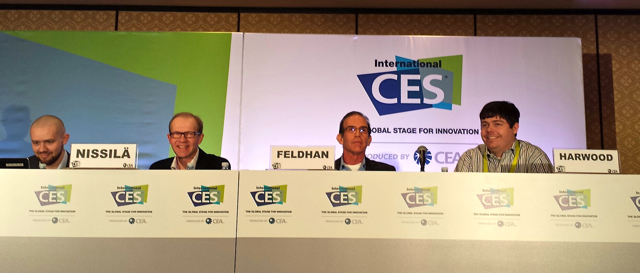CES Conference Session: Wearables as a Market Opportunity
January 6, 2015
Emerging trends in new wearables represent the next great market opportunity, say a group of consultants and analysts who cover the field. As part of the Sensors and MEMS Technology Conference at CES, panelists took to the stage to discuss “Wearables: A Very Real Market Opportunity.” Although current penetration of wearables is a mere seven percent, that number is expected to grow dramatically. “In the next five years we’ll have a wearable that the majority of the population will want,” said Jim Feldhan, president of Semico Research.
“I would expect that in five to eight years, we’ll probably see up to 20 percent penetration,” he predicts.
To the charge that wearables are hype, Seppo Nissila, CEO of SilverBlip, a consulting company in Finland, countered that, “wearables are real.”
“Samsung, LG, Apple are setting a kind of standard product to be followed by other players,” he said. “But we need to remember that there are many different approaches and new ideas that are shaking up the mobile business.”
“Wearables are a mix of hype and reality,” added Marwan Boustany, IHS senior analyst for MEMS and sensors. “Wearables are nice to have but not a must-have like a phone, so the numbers aren’t high.” Kevin Harwood, consulting architect at Mutual Mobile, believes wearables are “on the cusp of being real.”
Feldhan identifies four factors required for wearables to be successful. “We need to develop the use case,” he said. “We also need to develop battery life. Privacy and security are also big issues, and another important piece is cost. We’re seeing a lot of startups developing wearables, but the market is trying to figure out what the sustainable use model is.”
Everyone agreed on what the biggest wearables category will be in the near future. “Smartwatches is the major growth area, with Sony, Google, Samsung and Apple,” said Boustany. “But the growth of smartwatches is partially because they will eat into the fitness and heart monitors wearables category.”
Feldham also believes that the market will fragment. “Google Glass hasn’t taken off,” he said. “But smart glasses, in an industrial or manufacturing environment where the worker is already wearing safety goggles, would be a real opportunity. It won’t be smartphone volumes, but it’ll be a large market for someone.”
Hearables are another category that the experts believe will grow. “They will track how much and what you’re eating among other things,” said Harwood, who notes that it’s hard to compete on the wrist with all the major players in that space. A large number of people “already have earphones, so it’s easy to piggy-back on that existing market,” Boustany agreed.
The biggest obstacle to overcome is power/battery life. “You have to make the sensor draw less power,” said Harwood. “As we get more wearables in our life, people won’t want to plug five things in every night.” Alternative ways to charge wearables includes kinetic energy, body heat, and fabrics that passively draw solar power among others.
“The industry needs to make wearables light, thin, flexible and durable — and inexpensive to produce,” said Feldhan. “Once we standardize how wearables are produced, the prices will come down and we’ll see wearables market grow.”


No Comments Yet
You can be the first to comment!
Sorry, comments for this entry are closed at this time.